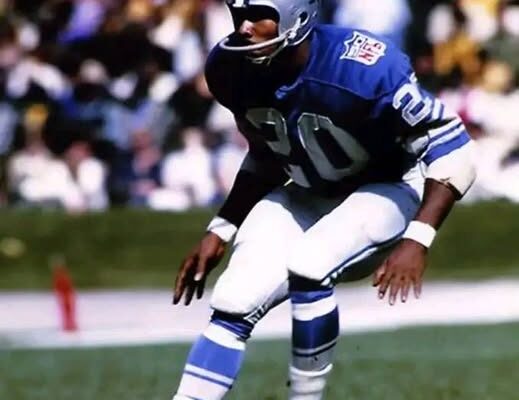The story of Lem Barney transcends the boundaries of sport, weaving together athletic brilliance, cultural impact, and humanitarian spirit into the tapestry of an American original. When the Detroit Lions selected the unheralded defensive back from Jackson State University in the 1967 NFL Draft, no one could have predicted he would become one of the most electrifying players in league history—a seven-time Pro Bowler, Super Bowl participant, and eventual Pro Football Hall of Famer whose career would redefine the cornerback position. Yet to reduce Barney’s significance to mere statistics (his 56 interceptions still rank 12th all-time) or accolades (including the 1967 Defensive Rookie of the Year award) would be to miss the essence of a man who became the rare athlete to leave an indelible mark both on and off the field.
Barney exploded onto the NFL scene with the audacity of a jazz virtuoso taking the stage at a smoky Detroit nightclub. His rookie season remains one of the most dominant debuts in league history—10 interceptions (three returned for touchdowns), 232 interception return yards, and a highlight reel of acrobatic plays that left quarterbacks muttering to themselves on the sideline. What made Barney special wasn’t just his 4.3 speed or balletic body control, but an almost supernatural ability to read quarterbacks’ intentions—a skill he attributed to his childhood habit of studying people’s movements while growing up in Gulfport, Mississippi. This intuitive understanding of human kinetics allowed him to develop his signature “banana technique,” where he’d intentionally trail receivers before breaking on the ball at the last possible moment, baiting quarterbacks into throws they instantly regretted.
The cultural context of Barney’s arrival in Detroit made his stardom even more remarkable. In 1967, the Motor City stood at the epicenter of America’s racial and economic tensions, just months away from the devastating riots that would reshape its landscape. As a Black rookie from an HBCU playing in a predominantly white league, Barney faced immense pressure both on and off the field. Yet he navigated these challenges with uncommon grace, using his platform to bridge divides. His locker became a gathering place for teammates of all backgrounds, united by his infectious humor and genuine interest in their lives beyond football. This ability to connect would later inspire Lions teammate Charlie Sanders to remark, “Lem didn’t just break up passes—he broke down barriers.”
Barney’s playing style revolutionized defensive back play during an era when the rules heavily favored receivers. In today’s pass-happy NFL, it’s difficult to appreciate how dominant he was during a time when defensive backs could barely touch receivers after five yards. His 1969 performance against the Baltimore Colts—where he intercepted Hall of Fame quarterback Johnny Unitas twice, returning one 98 yards for a touchdown—stands as a masterclass in shutdown coverage. Contemporary analysts reviewing game film marvel at how Barney’s fluid backpedal and explosive break on the ball anticipate modern techniques by decades. His versatility was equally astounding; in addition to defensive duties, he returned punts (averaging 11.3 yards per return with two touchdowns), kicked extra points when needed, and even lined up occasionally at receiver, catching 11 career passes.
Beyond the gridiron, Barney cultivated a multifaceted identity that defied the stereotypical jock persona. An accomplished musician, he recorded two R&B albums during his playing days, performing with Motown legends like Smokey Robinson. His 1970 single “You Can’t Judge a Book By Its Cover” became a regional hit, its lyrics subtly addressing racial prejudice through soulful metaphor. This creative outlet provided balance during the brutal NFL seasons, with Barney often bringing his guitar to training camp to lead teammates in impromptu jam sessions. His musical talents weren’t mere vanity projects—they reflected the same improvisational genius that made him so dangerous in the secondary, where he treated each play like a jazz solo, riffing on the quarterback’s tendencies.
Barney’s post-football journey reveals even greater depth. Rather than pursuing conventional broadcasting or coaching roles, he earned a Master of Divinity degree and became an ordained minister, dedicating himself to prison ministry and youth outreach in Detroit’s most underserved neighborhoods. His “Second Half” program, which helps former inmates rebuild their lives, has become a national model for faith-based rehabilitation. This work earned him the NFL’s prestigious Bart Starr Award for outstanding character and leadership, though he remains characteristically humble about the honor: “Football was what I did,” Barney often says. “Service is who I am.”
The Hall of Famer’s influence extends to today’s generation of defensive backs, who still study his film for lessons in anticipation and ball skills. All-Pro cornerback Jaire Alexander has called Barney “the original shutdown corner,” while Hall of Fame voter Peter King included him on his all-time underrated team, writing, “Barney played the position with a combination of artistry and intellect that hasn’t been matched.” Modern analytics back up this praise—when adjusted for era, Barney’s passer rating allowed (an estimated 45.3) would rank among the best in today’s NFL.
Perhaps Barney’s most enduring legacy lies in how he redefined what it meant to be a complete athlete during turbulent times. In an era when many players avoided controversy, he quietly supported the civil rights movement while maintaining relationships across racial lines. During the 1970 players’ strike, he became a key negotiator, bridging the gap between militant and conservative factions. His ability to balance fierce competitiveness with sportsmanship—he famously helped up opposing receivers after hard hits—set a standard that still resonates.
As the NFL evolves into its second century, Lem Barney’s multidimensional legacy serves as a reminder that greatness isn’t measured solely by championships or statistics, but by the lives touched and barriers broken. From the streets of Gulfport to the galleries of Canton, from the recording studio to the prison chapel, he has lived with the same authenticity and flair that once made him the most feared defensive back in football. The interceptions and touchdowns fade in memory, but the essence of Lem Barney—the artist, the minister, the trailblazer—endures as timeless as the game he elevated.
Today, as young cornerbacks emulate his techniques and Detroit schoolchildren benefit from his philanthropy, the full measure of Barney’s impact comes into focus. He wasn’t just a football player who happened to be talented in other areas; he was a Renaissance man who chose football as his first canvas. In an age of specialization, Barney’s life stands as a testament to the beauty of cultivating diverse passions—proof that a person can excel at the highest level of sport while developing profound talents beyond it. The Hall of Fame may enshrine his football achievements, but Lem Barney’s true legacy lives in the countless lives he’s transformed through faith, music, and unconditional compassion. That’s the mark of a champion whose work continues long after the final whistle.



